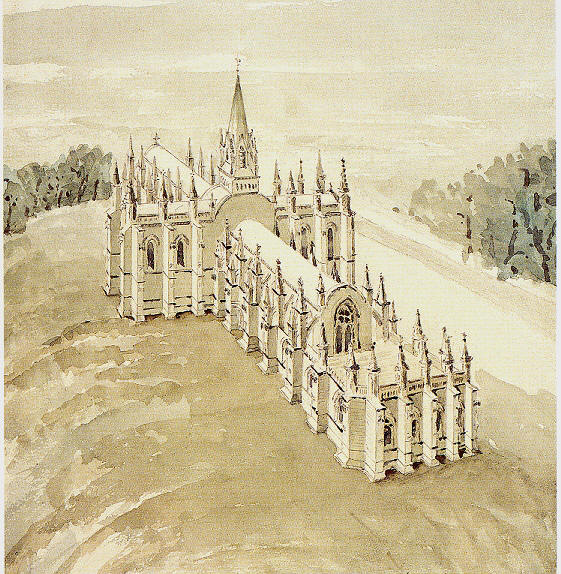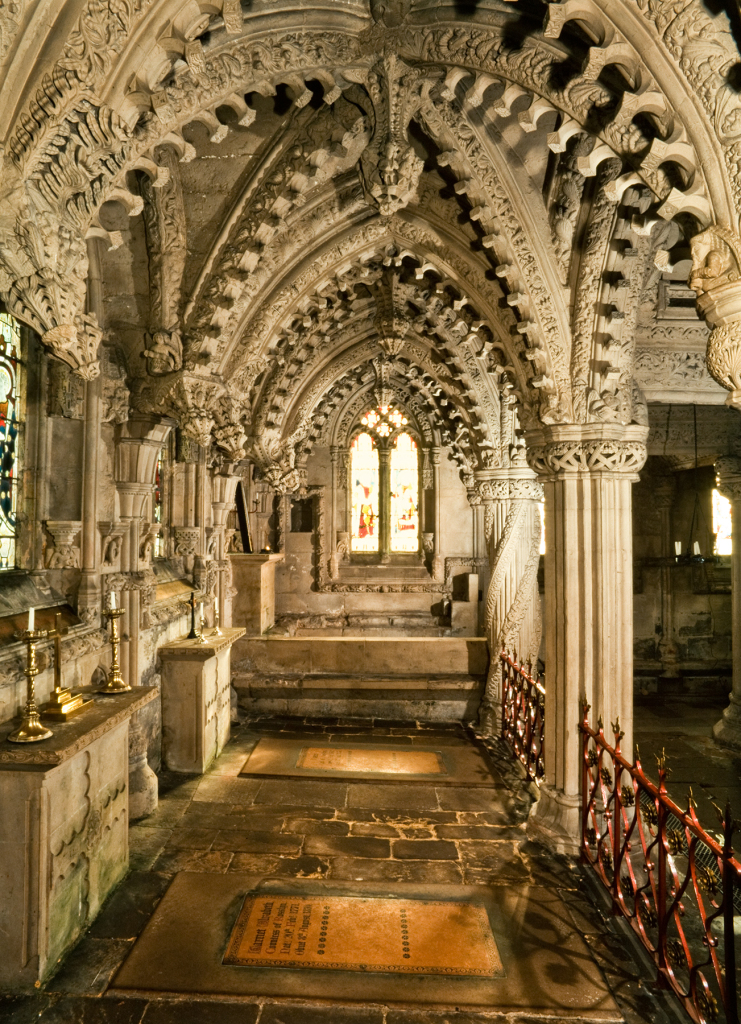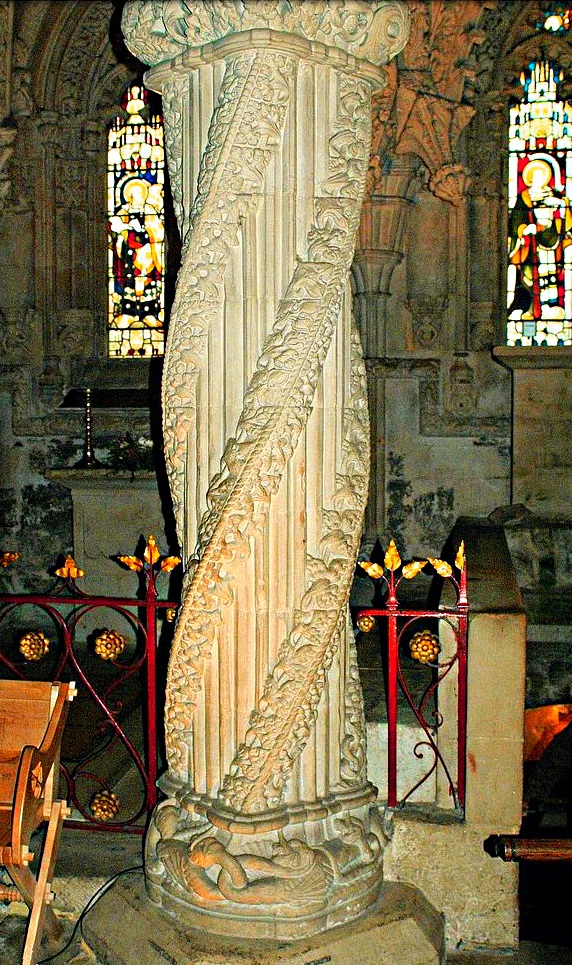‘Neath ancient Rosslyn waits secrets so secret nobody really knows what the secret is anymore. Some say the Knights of the Templar stored vast riches in the tombs of Rosslyn chapel and are perhaps even buried there themselves, dressed in full-plate armour. Some say the mummified head of Jesus Christ and perhaps even the sacred cup of Christ, the Holy Grail, is waiting in some secret chamber. Some say Rosslyn Chapel is the site of an alien landing pad, and perhaps the secret resting place of… Elvis?
Where these ridiculous stories about Rosslyn came from and why they’re spread is the real mystery, but it’s true that there’s something special about the church. Certain places in the world give off a special vibe, and Rosslyn Chapel is one of them. This magical energy comes not from a sacred cup, but rather the dedication and creativity of the ingenius stoneworkers Sir William St. Clair commissioned to build and decorate his holy house with a vast array of incredibly detailed carvings and sculptures. It was the 20th of September, 1456, when Sir William, First Earl of Caithness, had the grand idea of building a massive cathedral in the shape of a cross. Within this house of God the Earl’s monks would sing a set of daily prayers and songs throughout the day and night, and also celebrate Holy Mass for all the faithful departed, including the deceased members of the St. Clair family. In those days it was believed that the grander the chapel, the more hymns sung and the more prayers prayed, the greater your glory in heaven.

The grand building plan was never fully completed, only the choir was constructed, with the Lady chapel, and the foundations of what was to be the rest of the cathedral. After William St. Clair died in 1484, the rest of the project was abandoned from either lack of funds or the lack of interest from his kin. However, what Sir William had begun was magnificent on its own.
The entry fee into Rosslyn Chapel, thanks to Dan Brown’s ‘The Da Vinci Code‘, was a tad too expensive for our liking. Dan Brown’s famous novel had made the chapel into quite a popular tourist destination, and ever since then the Rosslyn Chapel Trust deemed it was worth 9 pounds to get inside this mystical, masonic church. Ashleigh and I were lucky that the person we were volunteering for and staying with, near Edinburgh, happened to be singing in a choir on one of the weekends we were there. We were able to get into the church for free, but only if we joined the choir and sang a few hymns with Roger and the gang within the lower chapel, which we did with as much gusto as we could manage.
After clumsily singing a few hymns in Latin, German, and French, we proceeded back upstairs and into the main chapel to gaze in wonder at the divinely inspired carvings.

Taking pictures inside the chapel wasn’t allowed, so other than the photograph above which I “borrowed” from the internet, you will have to use your imaginations. Every pillar, every archway, and every inch of the wall was carved out to represent different parables and important figures in history, including the St. Clair family of course, along with other Christian images. Some of the more famous carvings include the reoccurring Green Man, the Apprentice Pillar (or “Prentice Pillar”), The Dance of Death, Lucifer, and The Angel Playing the Bagpipes.
There are over 100 sculptures of “The Green Man” all around the chapel, pleasant to grotesque faces with vines and foliage growing all around them and sometimes out of their mouths. As you move from the east wall counter-clockwise to the north wall, the Green Men’s faces change from young to old. The rest of the engravings also follow this pattern; the whole east section of the chapel is concerned with the beginning of day, the start of life and spring. Shifting south the scene moves on towards the middle of the day, summer and the middle years of life. There are carvings of foliage depicting harvest time; there are fruits in abundance. Moving west dusk falls; the scenes represented are autumnal and the green men are aging. The roof represents the canopy of the heavens with stars and moons. Finally, coming round to the north, the chapel hits winter, the end of the day and the end of life. The green men are skeletons and carvings depicted at the north aisle are associated with death.
The “Prentice Pillar” is a work of art, an elaborately decorated pillar entwined with coils of leaves and vines (it also, coincidentally, resembles the double-helix of DNA). The pillar supposedly represents the Nordic Tree of Life, Yggdrasil, with serpents at the bottom eating at the tree’s roots. The story behind the name is this: the pillar was carved by an apprentice mason while the master was out travelling to gather ideas for the very same pillar. The apprentice had a dream about what the column should look like, and before the master returned the apprentice finished sculpting the most beautiful out of all the pillars. Everyone was impressed, that is, except the master mason. When the master returned, full of new ideas for the last column, he was angry to find the pillar standing already completed. The master mason flew into a jealous rage and struck the apprentice on the head with his mallet, killing him.
Okay, I can’t resist borrowing another picture from the world wide web… here is the “Apprentice Pillar”:

After hearing of all of this history and these stories, after hours of exploring its intricacies and its secrets, Ashleigh and I left feeling that perhaps 9 pounds isn’t too much to spend for a once in a lifetime look at this special church in Rosslyn.
For a more in depth look into Rosslyn Chapel, watch this documentary “A Treasure in Stone”, presented by the wife of the current Earl of Rosslyn.





